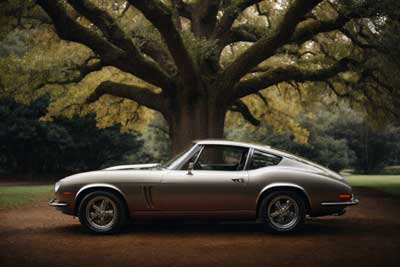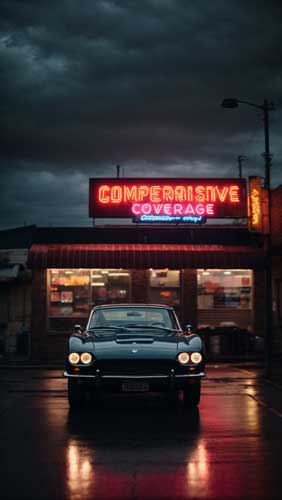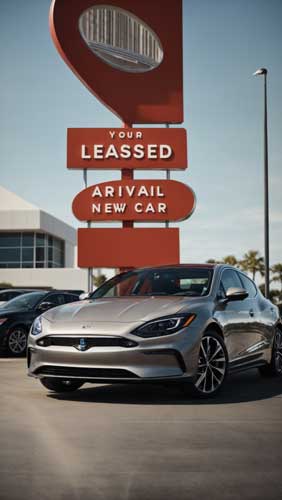Insurance Coverage For a New Car
Ensuring optimal coverage from the first drive.
An Exciting Experience
Buying a new car is an exciting experience but many people don’t put a lot of thought into insurance coverage. After doing your research and finding the perfect vehicle, you’ll want to make sure it is properly insured before driving it home.


The Right Auto Insurance Coverage
Having the right auto insurance coverage is crucial for protecting your investment and avoiding large out-of-pocket costs if an accident or damage occurs. This article will explore everything you need to know about insuring a new car, from the different types of coverage to add, how much insurance you need, strategies for lowering your premiums, and more. With the right information, you can make sure you have adequate protection for your new wheels.
Types of Auto Insurance Coverage
There are several key types of auto insurance coverage to understand when insuring a new vehicle:
- Liability insurance: This covers damages that you cause to others in an accident where you are deemed at fault. It pays for the other driver’s vehicle repairs and medical bills. Liability insurance has two components – bodily injury liability and property damage liability. The minimum coverage amounts required by law vary by state. However, experts recommend buying more than the minimum to properly protect your assets.
- Collision insurance: This covers damage to your vehicle from an accident, regardless of who is at fault. It will pay for repairs or the cash value of your car if it is totaled. Collision coverage is usually required if you have an auto loan or lease on your new car.
- Comprehensive insurance: This covers non-collision damage to your car from events like theft, vandalism, natural disaster, fire, or hitting an animal. It will pay to repair or replace your vehicle. Comprehensive insurance is also often required for auto loans and leases.
- Uninsured and underinsured motorist coverage: This pays for your medical bills and vehicle repairs if you are hit by a driver with no or insufficient insurance. It protects you when the at-fault driver cannot cover your losses. This coverage is mandatory in some states.
- Gap insurance: This specialty policy pays the difference between what your car is worth and what you still owe on your auto loan if your car is totaled. It helps avoid owing money if your new car is destroyed. Gap insurance can be purchased from your auto insurer or dealer.
- Other options: Roadside assistance, rental reimbursement, and extended warranties are other available add-ons. Roadside assistance covers help with lockouts, tire changes, towing, and more. Rental coverage pays for a rental car if your vehicle is in the shop after an accident. Extended warranties provide protection after the manufacturer’s warranty expires.
How Much Insurance Coverage Do You Need For a New Vehicle?
When insuring a new vehicle, it’s important to purchase adequate coverage limits and avoid being underinsured. Consider these tips:
- For liability insurance, it’s recommended to carry at least $100,000 bodily injury liability per person, $300,000 per accident, and $100,000 property damage liability. Higher limits are wise if you have significant assets.
- Buy enough collision and comprehensive coverage to replace your new car at its current value. New cars lose value quickly in the first years. Make sure your limits keep pace with depreciation.
- Carry uninsured/underinsured motorist bodily injury coverage equal to your liability limits. This will protect you in case an at-fault driver has minimum coverage or none at all.
- Get gap insurance if your downpayment is less than 20% of the car’s value. Gap insurance protects you if the vehicle is totaled and your loan balance exceeds its depreciated value.
Strategies to Lower Your Premiums
New cars are more expensive to insure because they cost more to repair and replace. But there are strategies to keep your insurance premiums down:
- Shop around: Get quotes from multiple insurers. Rates can vary significantly, so comparing options can save you hundreds per year.
- Ask about discounts: Insurers offer discounts like multi-policy, safe driver, anti-theft devices, good student, and more. Ask your insurer what discounts you may qualify for.
- Raise your deductible: Opting for a higher collision and comprehensive deductible of $500+, rather than $200-$500, can reduce your premiums. Just be sure you have savings to cover the higher deductible amount if needed.
- Drop unnecessary coverage: Once your auto loan is paid off, you can likely drop collision and comprehensive coverage, especially on an older car. Liability and uninsured motorist coverage are essential to maintain.
- Maintain good credit: Companies use credit-based insurance scores to set rates. Keeping your credit score high can help lower your premiums.
- Enroll in telematics: Insurers offer programs where your driving habits are monitored. Safe driving can be rewarded with policy discounts.

How to Insure a New Car Purchase
When you drive a new car off the dealer’s lot, here are some tips for getting insurance coverage:
- Let your insurer know you are buying a new car and provide them details like the year, make, model, vehicle identification number (VIN), and date of purchase. This will allow them to update your policy.
- Time your new policy start date with your car purchase date. Avoid gaps in coverage between your old car and your new car.
- Review your coverage limits and deductibles to make sure they align with your new car’s value and financing requirements. Inform your agent of any needed changes.
- Add the new car to any multi-car discounts your insurer offers to save money.
- Provide the dealer with proof of insurance so you can drive off the lot covered. Dealers will not release a newly purchased vehicle without this documentation.
- Pay your premium on time to avoid coverage lapses. Set up autopay or create payment reminders in your calendar so payments are made promptly each month or policy term.
How Car Insurance Coverage Works After an Accident
One key purpose of insurance is to protect you financially if an accident occurs. Here is an overview of how auto insurance works after you are in a crash:
- Call the police: For accidents involving injuries or major damage, request a police report. This creates an official record and is required for insurance claims. Exchange contact and insurance information with other drivers involved.
- Take photos: Document damage and the accident scene with cell phone pictures. Photos help support your insurance claim.
- Report to your insurer: Notify your agent or insurance company of the accident right away. Provide details of what happened and any police reports. This starts the claims process.
- Get a repair estimate: Take your car to an approved repair shop and get a written estimate for fixing the damage. Your insurer will use this to determine if the car is repairable or should be totaled.
- Pay deductible: Authorized repairs can begin after your collision or a comprehensive deductible is paid to the repair shop. Your insurer will cover eligible costs beyond the deductible.
- Receive payment: For a total loss, the insurer will pay the car’s actual cash value minus your deductible. The remaining loan balances still must be paid. Gap insurance can cover the difference between the car’s value and loan amount.
- Manage injuries: If injuries are involved, cooperate with your insurer’s injury claims process and provide documentation like medical reports and bills. Injury claims are paid separately from vehicle damage claims.
- Disputes: If there are disputes over fault or payment amounts, work through your insurer’s appeals process first before contacting a regulatory agency or attorney.
Getting into an accident with a new car can be upsetting. However, understanding the insurance claims process helps ensure you receive the payments you are entitled to so you can repair or replace your vehicle.
How to Save Money by "Dropping" Collision and Comprehensive Coverage
As cars age and you pay down the auto loan balance, it often makes financial sense to drop collision and comprehensive coverage. But it’s not an automatic decision. Consider these factors:

- Loan requirements: Your lender likely required you to carry these coverages. Once the loan is paid off, you can potentially drop them if it makes financial sense.
- Car value: If your car is only worth a few thousand dollars, the premiums may cost more than the vehicle is worth insuring. It may be prudent to drop coverage.
- Repair costs: Will repairs exceed the vehicle’s value? If so, collision and comprehensive insurance won’t make financial sense.
- Risk tolerance: How comfortable are you paying for repairs or total loss out-of-pocket versus paying for insurance premiums? Consider your financial situation.
- State laws: Some states have minimum liability coverage requirements to keep a car insured and registered which must still be met.
- Older cars: Once cars are around 8-10 years old, it often makes sense to drop collision and comprehensive. But evaluate it on a case-by-case basis.
- Compare quotes: Get quotes with and without the optional coverage to see the potential savings. Make an informed decision based on the numbers.
- Good driving record: The longer you’ve gone without an at-fault accident, the more reasonable it is to drop the extra coverage.
Dropping collision and comprehensive coverage can be a strategic way to reduce insurance costs as a vehicle ages. However, careful analysis is required to determine if the savings outweigh the risk you assume. Consult your agent when making coverage changes.
How Long Should You Keep Full Coverage on a Vehicle?
There is no set rule for how long to keep full coverage (collision and comprehensive) on a car. The optimal time to drop this optional coverage varies based on these guidelines:
- Follow loan requirements: Keep full coverage until your auto loan is paid off if required by the lender.
- Consider the car’s value: Once the vehicle value depreciates to 10-20% of its original cost, full coverage is harder to justify. The premiums may cost more than repairs.
- Review out-of-pocket costs: If you can easily afford $1,000-$2,000 for repairs or replacement if an accident occurs, full coverage is less necessary.
- Assess accident risk: Full coverage is wise for vehicles still driven frequently on risky roads or by new drivers.
- Calculate potential savings: Get quotes with and without full coverage to see the premium difference so you can make an informed decision.
- Buy older cars outright: If you fully own an older, inexpensive vehicle from the start, consider only carrying liability and uninsured motorist coverage.
- Drop coverage around 8-10 years: This is a common guideline, but still, evaluate each vehicle and situation individually.
- Compare costs annually: Reevaluate your coverage needs and options at each policy renewal to optimize savings.

While there is no perfect formula, following the above guidelines can help you determine when collision and comprehensive coverage is no longer a cost-effective use of your insurance premium dollars.
How Car Insurance Rates are Determined for Brand New Car Models
Insurers consider various factors when determining insurance rates for new vehicle models coming to market:

- Claim history: Industry claims data on damage, repair costs, and safety for similar makes and models guide initial rates. More claims mean higher rates.
- Vehicle price: Base rates correlate with the car’s sticker price and MSRP. More expensive vehicles have higher premiums.
- Repair complexity: New technology, materials, designs, or brands with fewer certified repair shops can increase costs and rates.
- Safety ratings: Vehicles with excellent crash test results and advanced safety features have lower risk and cheaper coverage.
- Theft rates: Models with high theft rates get higher premiums to compensate for break-in and theft claims. Security features help lower this risk.
- Performance: High-end finishes, luxury add-ons, powerful engines, and performance packages increase rates due to higher repair bills and total loss values.
- Driver demographics: Certain models attract younger drivers which insurers classify as higher risk, meaning more expensive coverage.
- Availability of parts: Limited availability of replacement parts can make repairs take longer and be more costly. Models with scarce parts have higher premiums.
- Hybrid/electric cars: New green technology can increase repair complexity and parts costs, but also indicates safety-focused drivers. Insurers account for both dynamics in rates.
As insurers get more data on real-world claims and driver behaviors for new models, they periodically refine rates based on emerging loss patterns. Initial rates are set based on careful analysis of all risk factors.
How Dealership Insurance Works When Test Driving a New Car
Taking a new car for a test drive is an essential part of shopping for your next vehicle. But what insurance protects you behind the wheel? Here is how dealership insurance works when test-driving a new car:

- Dealership coverage: The auto dealer’s insurance policy covers vehicles owned by the dealership, including cars available for test drives. This protects the dealer’s assets.
- Test drive terms: Sign a form at the dealership acknowledging rules for test drives, like route restrictions, mileage limits, and driver age requirements. Follow all terms to be insured.
- Primary insurance: The dealership’s insurance is primary coverage during an approved test drive. However, your personal auto policy may also provide secondary coverage.
- Valid license: You must hold a valid driver’s license to be insured during test drives. Dealers verify this before handing over the keys. Suspended or revoked licenses are not covered.
- Loaner cars: If you need a loaner car while your vehicle is being serviced, this also falls under the dealer’s insurance as a courtesy car.
- Test drive crashes: If you crash during a test drive, the dealer’s insurance handles claims and repairs. But the dealer may seek compensation from you if negligence on your part caused the accident.
- Personal belongings: Your personal insurance covers items stolen from the car during a test drive. The dealership policy doesn’t extend to your possessions.
- After purchase: Once you buy the car, it must be added to your own auto insurance policy for coverage as the registered owner.
Test drives allow you to properly evaluate a new car before purchase. Dealership insurance gives you the ability to test it safely.

Insurance Coverage For a New Leased Car
Leasing has become a popular option for acquiring new cars. It typically offers lower monthly payments than financing. But leases also come with insurance requirements to protect the vehicle:

- Read lease terms: The contract outlines required coverage types and minimum limits. Liability, comprehensive, and collision are typical requirements.
- Carry adequate limits: Your insurance limits must meet leasing minimums. Higher limits are wise to protect yourself from large out-of-pocket costs.
- List the leasing company: Name the lessor as “additional insured” and “loss payee” so they receive payments for damage and loss claims.
- Maintain continuous coverage: A lapse in insurance can trigger lease default. Set up autopay or calendar reminders for premiums.
- Pay deductibles: You must continue paying your chosen deductibles for claims rather than relying on waivers.
- No modifications: Leased cars can’t be altered without the lessor’s consent or it voids their insurance. Keep the car in its original condition.
- Protect your GAP: GAP insurance helps pay the remaining lease balances after an insurance settlement. Make sure you maintain GAP coverage.
- Avoid mileage overages: Stay within your mileage allowance to prevent financial penalties and higher mileage insurance rates.
- Check-in annually: Review coverage at renewal to ensure it still meets changing lease requirements as the car ages.
- Buy it or turn it in: At lease-end, you must either purchase the car, which requires obtaining a new owner’s coverage or return it to the lessor per agreement.
Properly insuring a leased vehicle protects the asset for both the lessor and lessee. Follow all insurance and lease guidelines closely to avoid penalties and coverage gaps.
Insurance Coverage For Expensive Luxury Vehicles and Sport Cars
Owning a high-end luxury or sports car requires special insurance considerations due to their high value, powerful performance capabilities, and expensive repair costs:
- Carry higher liability limits: Expensive cars can rack up high repair bills for other parties in an at-fault accident so increased liability limits are wise. $250,000 per person is a recommended minimum.
- Increase collision/comprehensive limits: Higher limits equal to the car’s value provide enough coverage to fully replace it in a total loss. Standard limits fall short for pricier cars.
- Add gap coverage: This pays the difference between the car’s value and any remaining loan balance if it’s totaled. Vehicles with high depreciation are good gap candidates.
- Inspect deductibles: Make sure you can afford deductibles like $1,000+ given the high-dollar repairs these vehicles often entail.
- Review policy exclusions: Some insurers limit or deny coverage for exotic or performance vehicles. Choose a company that insures luxury/sports cars without restrictive rules.
- Ask about discounts: Some providers offer discounts for insuring your home and car together or for insuring multiple cars including the luxury vehicle.
- Consider aftermarket part warranties: These provide protection should you add customized parts or performance upgrades. Factory warranties don’t cover modifications.
- Add roadside assistance: With repair costs at a premium, having complementary roadside help is useful for luxury car breakdowns.
- Review annually: Reassess your coverage as car values depreciate to ensure limits and deductibles still make sense.
- Drive safely: Speeding tickets, accidents, and reckless driving history can make these cars uninsurable. Maintain a clean record.
With higher car values comes greater insurance responsibility. Take the time to properly insure an expensive ride.
Title and Registration Fees for New Cars
Beyond just insurance, there are important title and registration fees to budget for when buying and insuring a new car:

- Sales tax: This varies by state but averages around 5%. It applies to the full vehicle purchase price including options. This substantial fee is due at purchase.
- Registration/plate fees: This statewide fee covers your license plates and registering the vehicle. It typically ranges from $20-$150 annually depending on your state.
- Title fees: A title transfer fee applies when the dealership handles title registration in your name, typically $20-$115 depending on the state.
- Inspection fees: Most states require an initial vehicle safety inspection, which costs $10-$50 to complete depending on the shop and state.
- Doc fees: Dealers may charge “document preparation fees” to handle paperwork, often $300-$600. These are not mandatory state fees.
- Luxury taxes: A small number of states apply extra taxes to purchase luxury vehicles priced over certain thresholds. Hawaii, for example, levies an additional tax on cars costing more than $60,000.
Conclusion
While minimum liability coverage provides basic protection, opting for higher limits and extras like collision, comprehensive, and uninsured motorist coverage provides more complete protection. Maintaining continuous insurance, a clean driving record, and a good credit score will also reward you with lower premiums. To check rates where you live, enter your zip code and fill out an online application. Save more on new car insurance coverage today.
